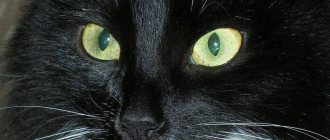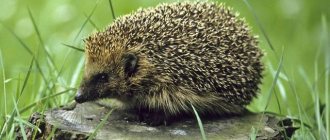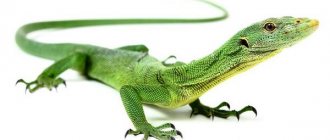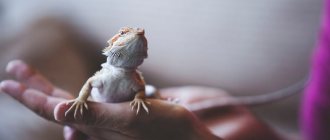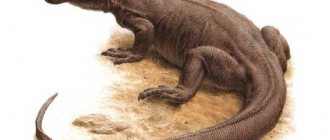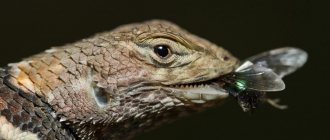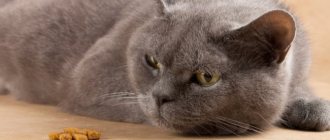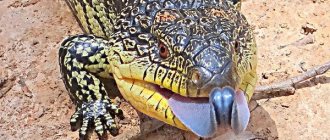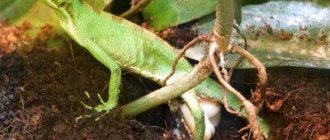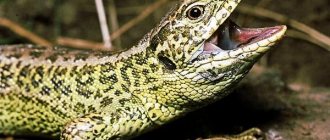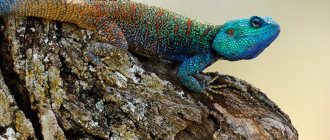Lizards are amazing reptiles. Most species (and there are more than 3,800 of them) are predators. Only a few are so-called “vegetarians”. Despite the fact that they are predators, for the most part they do not pose any threat to humans. Moreover, they can even become a true friend. It is for this reason that people often keep them at home, in specially equipped aquariums. And in today’s article we would like to talk about what lizards eat at home, in the wild, and what they should not eat.
Diet of wild reptiles
Lizards living in the wild obtain their own food. There are small and large species living on different continents, etc. But on average, their diet is the same:
- They feed on what they can find on the ground. Usually these are some kind of beetles, caterpillars or worms. Some species, the most dexterous, can catch insects such as flies, butterflies and dragonflies.
- They work in the gardens. The fact is that they really like Colorado potato beetles.
- The spindles have different preferences. These are lizards without legs that closely resemble snakes. These reptiles love earthworms, slugs, snails, and woodlice. They also prefer the larvae of various beetles.
- Lizards, like all living organisms, need vitamins. They get them by eating greens and vegetation, like cats and dogs.
- Naturally, they obtain water on their own, from streams, puddles, rivers and lakes.
Please note: Lizards are quite voracious creatures. Common reptiles can eat the approximate daily diet of a large bird.
Green iguana: appearance
Common iguanas are called green, but their colors can be any - red, black, purple. It all depends on the environment. Lizards are large in size - up to 1.7 m in length. Interestingly, almost a third is the tail. It grows up to 42 cm. Weight is variable - from 1.5 to 12 kg. The drier the climate, the less body weight.
The iguana has a memorable appearance:
- a long tail that serves as a serious weapon and helps to swim;
- longitudinal ridge from head to tip of tail;
- rough folds on the body and a “bag” on the neck;
- short paws with sharp claws;
- body covered with dense scales.
Common iguanas do not have webbed toes, so they are not well suited for life in water.
Homemade diet
If you have a reptile at home, then you can pamper it with insects such as flies, grasshoppers, crickets or worms. To prevent these insects from running all over the terrarium, you can first lightly squeeze them with tweezers.
They also love lizards and mealworms. Fishermen also call them bloodworms. Before serving such a delicacy in the terrarium, they first crush the head with tweezers.
Some lizards also eat beetles. But besides cockroaches, experienced lizard breeders do not recommend giving any other beetles. The fact is that they have a very rough shell.
If the lizard is large, then it can be fed with rats (small ones), mice, etc. You can also give small fish or pieces of fish and eggs.
Experts also recommend periodically feeding the reptile with cottage cheese.
Behavior in natural conditions
At the end of October, steppe lizards leave for the winter. In the spring, first the males emerge from their shelters, and only after them the females. In the off-season, the peak of activity occurs in the middle of the day, and in the summer, agamas are mainly in the morning and evening.
Agamas jump beautifully. They can jump from branch to branch at a distance of up to 80 cm. They move quickly on the ground, almost on straight legs, without touching the ground with their tail. In villages you can find agamas moving along vertical clay and stone walls.
Diet of different types
The sand lizard in the wild feeds on small snakes, grasshoppers, crickets, caterpillars, etc. At home, you can feed it with similar insects: grasshoppers, crickets, worms, flies, etc. It is also recommended to give her a mixture of carrots and pieces of meat.
Chameleons are most often fed cockroaches, flies and grasshoppers. To replenish vitamins in the reptile’s body, you need to give it a piece of banana, orange or other fruit. You can, of course, buy dietary supplements, but it is expensive and not as environmentally friendly as a piece of fresh fruit.
Geckos eat only live food: cockroaches, flies, grasshoppers, etc. Larger individuals do not mind eating mice or baby rats. You can also include quail eggs in your diet. There should always be water and bird stone powder in the terrarium. In the latter, insects are constantly encased before being fed to the gecko. This is necessary to replenish calcium reserves. You need to coat insects in powder daily, as well as give dry vitamins. But liquid vitamins are given once every 7 days.
It is very difficult to keep Moloch at home. All because of her selective diet. The lizard feeds only on ants and eats nothing else. At one time she can swallow up to 2500 insects. Naturally, keeping a moloch in a house is a very expensive business.
Skinks can be fed the same insects as the above species. They don't mind eating crickets, flies, and cockroaches. These reptiles are so picky that they even eat kitten and dog food.
The iguana is a purely herbivorous reptile. But this does not make its content simple. In the wild, it only eats leaves from trees. In captivity, it can be fed lettuce, spinach and cabbage. You can also supplement your diet with carrots and legumes. It is recommended to give fruits in small quantities.
Monitor lizards are the most unpretentious pets. These huge lizards eat not only live mice and insects. They don’t mind enjoying food with a “smell.” In captivity they are fed rats, mice, eggs, fish, cockroaches and the list goes on.
Common lizard breeding. Sanding lizard: reproduction
This type of lizard is widespread in southern England and Europe, as well as on the Balkan Peninsula, eastern France, Belarus, the Baltics, Asia Minor and Ukraine. The usual habitat for the sand lizard is dry, well-warmed steppes, forests and mountains of medium height.
Due to their color (greenish-brown or brown), they are perfectly camouflaged among grass and stones. As a place of residence, animals choose shallow burrows, depressions under stones or in the root systems of trees and large plants. Here lizards wait out the cold times.
Individuals usually live in pairs. There are some differences in color between males and males. For example, male animals are pale green or dark gray in color. Individuals living in warm regions surprise with their bright green color. Females are often inconspicuous: gray color predominates.
The young sand lizard has characteristic stripes along its back. Reproduction in animals occurs mainly during daylight hours in early spring. Males behave quite unusually during these periods: they raise their body above the ground on their front legs and begin to look around. In this way they find a suitable match for themselves. As soon as the male notices a suitable female, he immediately follows her.
His main goal is to grab the female by the base of her tail. Paradoxically, females do not throw back their tail at such moments, despite the pain. Then the male clasps the body with his paws and begins the mating process. Often during the mating season, nimble lizards organize fights for female representatives.
After the lizards have reproduced, the females begin laying eggs in late May - early June. On average, you get about 6-16 eggs. Future female cubs are buried in shallow holes dug previously. There is also an option when a fast lizard lays eggs in a shelter where it takes refuge. But it is also possible that mothers leave their nesting sites once and for all.
It is worth noting that the eggs of sand lizards are quite large, oval in shape and reach 1.5 centimeters in length. They contain a large amount of nutritious yolk, thanks to which the embryo develops.
What not to feed reptiles
In general, there are no restrictions in their diet. The only thing that needs to be observed is the “purity” of the food. For example, you cannot feed them cockroaches that you caught in the entrance. The fact is that they can be poisoned. The cockroach doesn’t care, they are used to poisons, but it will cause irreparable harm to our pet.
Also, it is not recommended to feed them field insects. Fields are often sprayed with insecticides against parasites, and these poisons can remain on the body of the bug. It is better to buy insects in pet stores, catch them in your garden, or in areas where chemical treatments are not carried out.
It is also advisable to feed lizards with moving insects, since most species do not eat dead food.
Area
The habitat includes two unequal parts, separated from each other by approximately 600 km. Scientists believe that the area used to be intact, but about 7 thousand years ago, during the transgression of the Caspian Sea, a gap formed.
Currently, most of the population lives in Central Asia, the northern parts of Afghanistan and Iran, northwestern China, and southern Kazakhstan. Steppe lizards of the second group inhabit the semi-deserts of Dagestan, the Stavropol Territory of the Russian Federation and Chechnya. The Asian part of the range is much larger in area than the European part.
Nuances
In order for a pet to live a long time, it is necessary to take good care of it. To do this you need to follow a few tips:
- You don't need to feed your pet right away in the morning. Usually, after waking up, lizards take a “bath” (wash themselves) and bask in the sun (an ordinary daylight lamp will do). Only then are they ready for breakfast.
- The terrarium should have a stable, moderate temperature. They cannot tolerate heat or cold.
- You cannot feed them during the day.
- At night you need to turn off the lights so that nothing disturbs them.
- If your pet has lost his appetite, then most likely the reason is the need for reproduction.
- In winter you need to increase the amount of vitamins. Otherwise, many species simply hibernate.
We hope our article helped you find out what lizards eat in nature and at home.
Iguana and man
The relationship between iguanas and humans goes back hundreds of years. The ancient tribes of South America worshiped large lizards, they were deified and sometimes sacrificed. This cult gradually disappeared with the arrival of the conquistadors.
In Mexico and some other countries, meat is used for cooking. The most famous dishes:
- roast guisado;
- birria;
- coconut stew.
Iguanas have been very popular pets lately. However, their sale is controlled to avoid extinction of the species.
Popular questions
How often should you feed your lizard?
What about the diet is more or less clear, but we will return to this issue a little later, but what should be the frequency of feeding of these reptiles? If you think that lizards, just like house spiders, can live for a long time without food, the main thing is that there is water, then you are mistaken. Lizards need several meals a day, and in the hot season it needs to be fed 3 times a day, while for the colder season it is enough to feed the pet 2 times a day. The time for feeding is chosen when the lizard is active. If you have several lizards, then make sure that the reptiles do not fight over food, therefore, it is better to feed them in different terrariums. After the lizard has eaten, it is better to remove the remaining food. Putting a reptile on a diet and limiting its food intake is not worth it. As a result of malnutrition, the pet may begin to get sick and die.
What to do if your lizard refuses to eat?
This question is very often asked by reptile owners who are not yet accustomed to their status as a lizard breeder. Well, perhaps you just simply overfed your pet, and he decided to arrange a couple of fasting days for himself. Just watch the lizard's behavior - if it is still active, drinks water well, but simply refuses food or eats very little - it's not scary. The reptile may thus be relieving its body from your overfeeding (a symptom of the latter is frequent belching), or perhaps it is clearly hinting to you that what you are feeding it is not to its taste. In this case, it is recommended to reconsider the diet of your pet or pet. It is not uncommon for young lizards to refuse to feed themselves. In this situation, you can try to interest the reptile in breakfast or lunch in the following way - squeeze out the contents of the mealworm and lubricate the lizard's mouth with it. She will definitely lick it off, and then, having tasted the delicacy, will greedily reach for food.
Does a lizard need vitamins?
If you want your reptile to be healthy, look bright, and behave lively, it must include vitamins and minerals in its diet. If you have a vegetarian lizard, you can crush these vitamins and minerals and mix them with rice and fruit. For predator lizards, you can prepare a mixture of food insects and add vitamin powder to it. Some owners even specifically inject mice and rats with vitamins before giving them to their lizard to eat, or inject the latter with minerals in gelatin capsules. To do this or take a simpler path - each owner must decide for himself. The main thing is to avoid those substances that can scare your pet away from food or spoil his appetite... By the way, calcium can be given to lizards in the form of cuttlefish shells or in the form of crushed eggshells (eggs must be raw).

